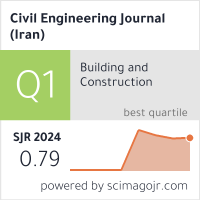Utilization of Sand Cushion for Stabilization of Peat Layer Considering Dynamic Response of Compaction
Downloads
Doi:10.28991/CEJ-2024-010-04-011
Full Text:PDF
Downloads
[2] El Mouchi, A., Siddiqua, S., Wijewickreme, D., & Polinder, H. (2021). A Review to Develop new Correlations for Geotechnical Properties of Organic Soils. Geotechnical and Geological Engineering, 39(5), 3315–3336. doi:10.1007/s10706-021-01723-0.
[3] Hobbs, N. B. (1986). Mire morphology and the properties and behaviour of some British and foreign peats. Quarterly Journal of Engineering Geology, 19(1), 7–80. doi:10.1144/gsl.qjeg.1986.019.01.02.
[4] Edil, T. B., & Dhowian, A. (1981). At-rest lateral pressure of peat soils. Journal of the Geotechnical Engineering Division, ASCE, 107(GT2, Proc. Paper, 16063), 201–217. doi:10.1061/ajgeb6.0001097.
[5] Edil, T. B. (2003). Recent advances in geotechnical characterization and construction over peats and organic soils. Proceedings 2nd International Conference on Advances in Soft Soil Engineering and Technology, 2-4 July, 2003, Putrajaya, Malaysia.
[6] Hayashi, H., & Nishimoto, S. (2005). Strength characteristic of stabilized peat using different types of binders. Proceedings of the International Conference of Deep Mixing Best Practices and Recent Advances, Deep Mixing, 23-25 may, 2005, Stockholm, Sweden.
[7] í…hnberg, H. (2006). Strength of stabilised soil-a laboratory study on clays and organic soils stabilised with different types of binder. PhD Thesis, Lund University, Lund, Sweden.
[8] Black, J. A., Sivakumar, V., Madhav, M. R., & Hamill, G. A. (2007). Reinforced Stone Columns in Weak Deposits: Laboratory Model Study. Journal of Geotechnical and Geoenvironmental Engineering, 133(9), 1154–1161. doi:10.1061/(asce)1090-0241(2007)133:9(1154).
[9] Chen, H., & Wang, Q. (2006). The behaviour of organic matter in the process of soft soil stabilization using cement. Bulletin of Engineering Geology and the Environment, 65(4), 445–448. doi:10.1007/s10064-005-0030-1.
[10] Islam, S., & Hashim, R. (2008). Stabilization of peat by deep mixing method: a critical review of the state of practices. Electronic Journal of Geotechnical Engineering, 13.
[11] Duraisamy, Y., Huat, B. B. K., & Muniandy, R. (2009). Compressibility behavior of fibrous peat reinforced with cement columns. Geotechnical and Geological Engineering, 27(5), 619–629. doi:10.1007/s10706-009-9262-3.
[12] Heneash, U., Fawzy, H. E. D., Ali, K., & Basha, A. (2023). Utilization of Ionic Organic Polymer to Improve Performance and Properties of Problematic Soils. Civil Engineering Journal (Iran), 9(12), 3019–3037. doi:10.28991/CEJ-2023-09-12-05.
[13] Š iukŠ¡Äius, A., Vorobjovas, V., & Vaitkus, A. (2018). Geogrid reinforced road subgrade influence on the pavement evenness. IOP Conference Series: Materials Science and Engineering, 356, 012020. doi:10.1088/1757-899x/356/1/012020.
[14] Jarrett, P. M. (1986). Load tests on geogrid reinforced gravel fills constructed on peat subgrades. 3rd International Conference on Geotextiles, 7-11 April, 1986, Vienna, Austria.
[15] Mooney, M. A. (2010). Intelligent soil compaction. Transportation Research Board, Washington, United States.
[16] Fathi, A., Tirado, C., Rocha, S., Mazari, M., & Nazarian, S. (2021). Assessing depth of influence of intelligent compaction rollers by integrating laboratory testing and field measurements. Transportation Geotechnics, 28, 100509. doi:10.1016/j.trgeo.2020.100509.
[17] Adams, M. T., & Collin, J. G. (1997). Large Model Spread Footing Load Tests on Geosynthetic Reinforced Soil Foundations. Journal of Geotechnical and Geoenvironmental Engineering, 123(1), 66–72. doi:10.1061/(asce)1090-0241(1997)123:1(66).
[18] Basha, A., khalifa, F., & Fayed, S. (2023). Experimental Study on Effect of Recycled Reinforced Concrete Waste on Mechanical Properties and Structural behaviour of the Sandy Soil. International Journal of Concrete Structures and Materials, 17(1), 52. doi:10.1186/s40069-023-00612-5.
[19] Duraisamy, Y. (2008). Compressibility behavior of tropical peat reinforced with cement column. PhD Thesis, Universiti Putra Malaysia, Serdang, Malaysia.
[20] ASTM D1195/D1195M-21. (2021). Standard Test Method for Repetitive Static Plate Tests of Soils and Flexible Pavement Components for Use in Evaluation and Design of Airport and Highway Pavements. ASTM International, Pennsylvania, United States. doi:10.1520/D1195_D1195M-21.
[21] ASTM D1194. (2012). Test Method for Bearing Capacity of Soil for Static Load and Spread Footing (Withdrawn 2003). ASTM International, Pennsylvania, United States.
[22] Annual Book of ASTM Standards. (1989). Soil and Rock; Building Stones: Geotextiles/Vol 04.08/Pcn01040889-38. ASTM International, Pennsylvania, United States.
[23] Chen, Q., & Abu-Farsakh, M. (2011). Numerical Analysis to Study the Scale Effect of Shallow Foundation on Reinforced Soils. Geo-Frontiers, 595–604. doi:10.1061/41165(397)62.
[24] Nasr, A. M. A., & Azzam, W. R. (2017). Behaviour of eccentrically loaded strip footings resting on sand. International Journal of Physical Modelling in Geotechnics, 17(3), 177–194. doi:10.1680/jphmg.16.00008.
[25] Azzam, W. R., & Nasr, A. M. (2015). Bearing capacity of shell strip footing on reinforced sand. Journal of Advanced Research, 6(5), 727–737. doi:10.1016/j.jare.2014.04.003.
[26] Lee, A. (2002). Finite element analysis in geotechnical engineering. Theory and Application, Thomas Telford, London, United Kingdom.
[27] Bathelt, U. (1956). The working behavior of the vibrating compactor on plastic-elastic ground: With 47 images. Ph.D. Thesis, Ernst & Sohn, Germany. (In German).
[28] Moshin, S. H. (1967). Investigations of the dynamic behavior of ramming systems. Baumaschine und Bautechnik, 14(1), 11-17. (In German).
[29] Yoo, T.-S., & Selig, E. T. (1979). Dynamics of Vibratory-Roller Compaction. Journal of the Geotechnical Engineering Division, 105(10), 1211–1231. doi:10.1061/ajgeb6.0000867.
[30] Azzam, W. R. (2015). Utilization of the confined cell for improving the machine foundation behavior-numerical study. Journal of GeoEngineering, 10(1), 17–23. doi:10.6310/jog.2015.10(1).3.
[31] Roudgari, R. (2012). Compaction of Soil by Repeated Loading. PhD Thesis, Concordia University, Montreal, Canada.
[32] Paulmichl, I., Furtmüller, T., Adam, C., & Adam, D. (2020). Numerical simulation of the compaction effect and the dynamic response of an oscillation roller based on a hypoplastic soil model. Soil Dynamics and Earthquake Engineering, 132, 106057. doi:10.1016/j.soildyn.2020.106057.
[33] Ochiai, H., Watari, Y., & Tsukamoto, Y. (1996). Soil reinforcement practice for fills over soft ground in Japan. Geosynthetics International, 3(1), 31–48. doi:10.1680/gein.3.0052.
[34] Madhav, M. R., & Vitkar, P. P. (1978). Strip Footing on Weak Clay Stabilized with a Granular Trench or Pile. Canadian Geotechnical Journal, 15(4), 605–609. doi:10.1139/t78-066.
[35] Das, B. M., & Puri, V. K. (1989). Bearing capacity of shallow foundations on granular trench in weak clay. Numerical Models in Geomechanics. NUMOG III, 5(5), 289–296. doi:10.1016/0148-9062(91)92547-c.
- Authors retain all copyrights. It is noticeable that authors will not be forced to sign any copyright transfer agreements.
- This work (including HTML and PDF Files) is licensed under a Creative Commons Attribution 4.0 International License.![]()















